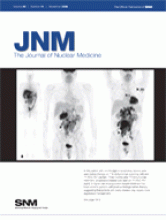OtherBASIC SCIENCE INVESTIGATIONS
Fluorescence Reflectance Imaging of Macrophage-Rich Atherosclerotic Plaques Using an αvβ3 Integrin–Targeted Fluorochrome
Jens Waldeck, Florian Häger, Carsten Höltke, Christian Lanckohr, Angelika von Wallbrunn, Giovanni Torsello, Walter Heindel, Gregor Theilmeier, Michael Schäfers and Christoph Bremer
Journal of Nuclear Medicine November 2008, 49 (11) 1845-1851; DOI: https://doi.org/10.2967/jnumed.108.052514
Jens Waldeck
Florian Häger
Carsten Höltke
Christian Lanckohr
Angelika von Wallbrunn
Giovanni Torsello
Walter Heindel
Gregor Theilmeier
Michael Schäfers
In this issue
Journal of Nuclear Medicine
Vol. 49, Issue 11
November 2008
Fluorescence Reflectance Imaging of Macrophage-Rich Atherosclerotic Plaques Using an αvβ3 Integrin–Targeted Fluorochrome
Jens Waldeck, Florian Häger, Carsten Höltke, Christian Lanckohr, Angelika von Wallbrunn, Giovanni Torsello, Walter Heindel, Gregor Theilmeier, Michael Schäfers, Christoph Bremer
Journal of Nuclear Medicine Nov 2008, 49 (11) 1845-1851; DOI: 10.2967/jnumed.108.052514
Fluorescence Reflectance Imaging of Macrophage-Rich Atherosclerotic Plaques Using an αvβ3 Integrin–Targeted Fluorochrome
Jens Waldeck, Florian Häger, Carsten Höltke, Christian Lanckohr, Angelika von Wallbrunn, Giovanni Torsello, Walter Heindel, Gregor Theilmeier, Michael Schäfers, Christoph Bremer
Journal of Nuclear Medicine Nov 2008, 49 (11) 1845-1851; DOI: 10.2967/jnumed.108.052514
Jump to section
Related Articles
Cited By...
- 64Cu-Labeled Divalent Cystine Knot Peptide for Imaging Carotid Atherosclerotic Plaques
- In Vivo Evaluation of Angiogenic Activity and Its Correlation with Efficacy of Indirect Revascularization Surgery in Pediatric Moyamoya Disease
- PET/CT Imaging of Integrin {alpha}v{beta}3 Expression in Human Carotid Atherosclerosis
- Claudin-4-targeted optical imaging detects pancreatic cancer and its precursor lesions
- Integrin-Targeted Imaging of Inflammation in Vascular Remodeling
- Evaluation of {alpha}v{beta}3 Integrin-Targeted Positron Emission Tomography Tracer 18F-Galacto-RGD for Imaging of Vascular Inflammation in Atherosclerotic Mice
- Optical and Multimodality Molecular Imaging: Insights Into Atherosclerosis







